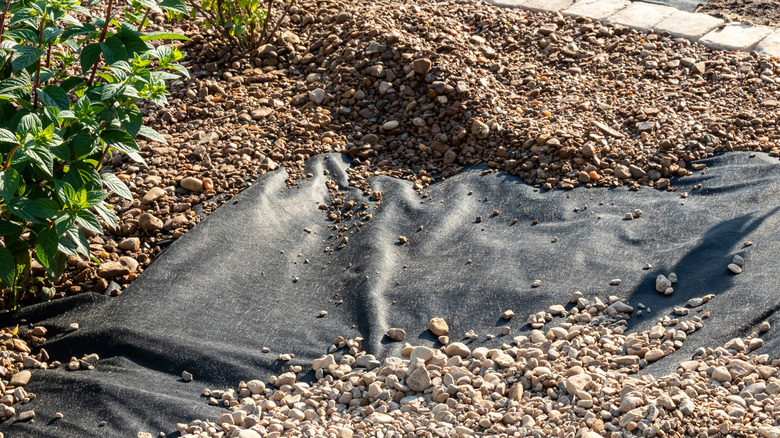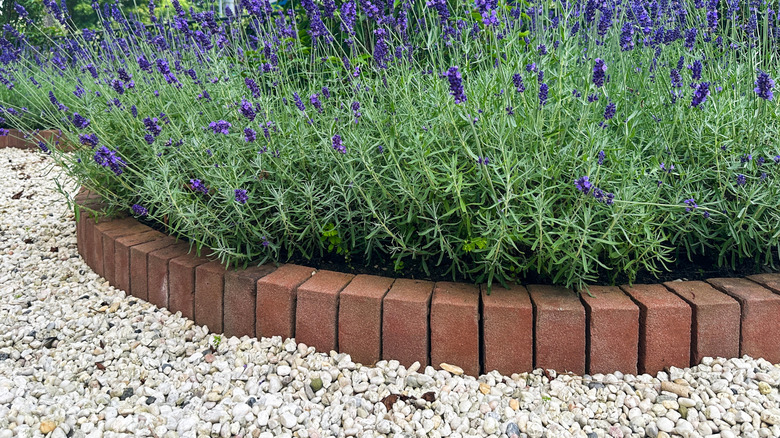Skip The Landscape Fabric Under Gravel & Try A Natural Alternative To Keep Weeds Away
Whether in a large area like a driveway or a small spot like around garden beds, gravel can add an interesting texture and color to any landscape. It offers other benefits, too, including its excellent drainage, sustainability, and lower maintenance needs than other ground cover options. However, the one frustrating feature of gravel for many homeowners is the weeds that manage to poke their way up through the gaps between the crushed rock. Covering the area with landscaping fabric before adding the gravel is usually the recommended way to prevent weed growth, but landscaping fabric has its detractors, who cite issues with soil compaction, chemicals from the synthetic material leaching into the soil, making weeding and reseeding more difficult, and the cost as reasons to avoid it.
Fortunately, burlap makes an ideal alternative to landscaping fabric — even Martha Stewart recommends upcycling used burlap to prevent weeds. It is a natural material made from the fibers of the jute plant and can help protect the health of your soil, so you don't have to worry about the negative impacts it might have on your yard. It's used and installed under gravel in much the same way as landscaping fabric, too, making it an easy DIY project.
Advantages of burlap as a weed barrier under gravel
Burlap and other alternatives to landscaping fabric prevent weed growth by blocking sunlight from reaching the soil while still allowing water and other nutrients to pass through. This material is also biodegradable, so over time, it breaks down naturally, returning organic material to the earth rather than leaving a layers of plastic and synthetic matter like landscaping fabric. However, while it eventually decomposes, burlap is resistant to the sun's UV rays and holds up well even in heavy rain, so it can often last three to five years.
It's not simply a matter of burlap not adding anything harmful to your soil, though. The organic matter that it delivers to the ground actually helps fortify the soil. It can provide nutrients for insects that benefit your garden and lawn, encouraging healthy plant and grass growth. It also helps reduce evaporation, so the soil's moisture level will remain balanced.
While burlap is an excellent alternative to landscaping fabric in many applications, it's not suitable for all uses. It typically works best as a weed barrier for smaller gravel-covered areas that don't get much foot traffic, like garden beds. It likely won't hold up well in a gravel driveway under the weight of your car, where woven geotextile landscaping fabric is usually the best option for strength, support, and weed protection.
Using burlap to prevent weeds under gravel
To keep weeds out of your gravel for good, it's best to prevent them from growing in the first place. As a weed barrier under gravel, burlap is installed using the same method as synthetic landscaping fabric. Start by clearing the area of any existing weeds, rocks, or other debris. It's important to remove weeds at their roots to ensure that they won't grow back. Lay down the burlap sheets to cover the area, allowing them to overlap by about a foot to ensure that there are no gaps where weeds might poke through. If there are existing plants in your landscape, use a utility knife to make slits or cuts in the burlap to accommodate them.
To ensure that the burlap stays in place, it's best to secure it with metal landscaping staples or pins. Push them through the material and into the soil every 12 to 18 inches along the perimeter of the area to anchor the burlap in place. If the ground is hard or firm, you can use a hammer to drive them in. Next, install any edging you plan to use along the ends of the fabric to keep the gravel contained. You can then spread rocks over the burlap, and enjoy the new weed-free gravel element in your yard.


